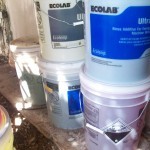As a Shipper of a hazardous material it is your responsibility to choose the authorized packaging specified for that HazMat in column 8 of the Hazardous Materials Table that also conforms to any applicable special provisions found in column 7. You must also fill and close the packaging as directed by the regulations and the instructions of the packaging manufacturer. In addition to that you must also comply with the General Requirements for Packagings and Packages found at 49 CFR 173.24.
What is the difference between a package and a packaging?
ANSWER: Both are defined at 49 CFR 171.8, a packaging is the receptacle and any components or materials necessary for the containment of the hazardous material. The package is the packaging and its contents. In other words, the packaging is the receptacle you select for the containment of your HazMat, while the package is the packaging and the HazMat once it is closed, sealed, and ready for transportation.
Applicability:
The general requirements (49 CFR 173.24) apply to all of the following:
- Bulk and non-bulk packagings.
- New and reused packagings.
- Specification and non-specification packagings.
Note that additional general requirements for non-bulk and bulk packagings can be found at §173.24a and §173.24b, respectively.
Requirements:

HazMat packages must be:
- Designed and constructed and;
- Maintained, filled, its contents limited, and closed…
…So that under normal transportation conditions the following will not occur:
- No identifiable (without the use of instruments) release of HazMat.
- The effectiveness of the package will not be substantially reduced (ie. damaged so that it can no longer contain the HazMat).
- No mixture of gases or vapors in the package resulting in heat or pressure that could significantly reduce the effectiveness of the packaging.
- No HazMat residue on the outside of the package.
The conditions of “normal transportation” will vary depending on the mode of transport (eg. aircraft, highway, rail, vessel), and include:
- Minimum and maximum temperature.
- Changes in humidity and pressure.
- Shocks and vibrations from loading and unloading.
- Exposure to the elements.
The “effectiveness of the package” refers to characteristics such as its:
- Impact resistance.
- Strength
- Durability
If the authorized packaging required by the regulations must be a specification packaging, then it must conform to the applicable specifications or standards of Parts 178 and 179 of the Hazardous Materials Regulations (refer to 49 CFR 173.24(d) for more information).
Whatever the HMR may require for a packaging, it is nonetheless the responsibility of the Shipper to ensure the HazMat is compatible with the specified packaging. Particular attention must be given to issues such as:
- Corrosivity
- Permeability
- Softening
- Premature aging.
- Embrittlement
In addition, there must be no significant chemical or galvanic reaction between the HazMat and the packaging.
No hazardous materials may be packaged with other HazMat or non-hazardous materials if the materials are capable of reacting dangerously with each other.
If a hazardous material in a solid form may become a liquid during transportation (consider all the possible conditions of transportation), the packaging must be able to contain the HazMat in the liquid state as well.
The requirements specific to plastic packagings and receptacles are found at 49 CFR 173.24(e)(3) and summarized below:

- The plastic used in the packaging/receptacle must be compatible with the HazMat.
- Permeability of the plastic must not allow a hazardous condition to occur.
- A plastic packaging or receptacle used for liquid HazMat must meet the test requirements of Appendix B to 49 CFR part 173. A higher level of compliance is required for packing group I materials and Division 6.1 Poisons when plastic packaging or receptacles are used.
The closures of HazMat packages must be designed and closed so that:
- There is no detectable release of hazardous material (unless venting is necessary).
- The closure is leakproof and secured against loosening.
- Closures on packages for air transport must be held in place by positive means (eg. screw-on, snap-on, or push-on lids secured by tape).
- Closure on specification packaging must follow the instructions provided by the packaging manufacturer.
Venting of packagings is permitted, but the following conditions must be considered:
- The purpose of the venting must be to reduce internal pressure within the package due to the build-up of gas.
- Transportation can’t be by aircraft unless the HazMat is cryogenic liquids specified by §173.320(c) or carbon dioxide, solid (dry ice).
- With some exceptions, vented gases can’t be poisonous, likely to create a flammable mixture with air, or an asphyxiant.
- Venting of bulk packagings have additional limitations identified in §173.24(g)(4 & 5).
A packaging for liquid HazMat must be filled so that sufficient ullage (outage) is left for expansion that may occur. There are specific requirements for the filling of non-bulk and bulk packagings at §§173.24a(d) and 173.24b(a), respectively. There are also filling limits for compressed gases and cryogenic liquids, refer to §173.24(h)(2).
What is meant by outage or ullage?
ANSWER: Outage or ullage means the amount by which a packaging falls short of being liquid full, usually expressed in percent by volume.
And finally, the transportation of HazMat by aircraft must comply with the general packaging requirements of 49 CFR 173.27.
Remember that these general requirements will apply to almost every shipment of HazMat and are in addition to other requirements found in the Hazardous Material Regulations.
Another requirement you can’t overlook is to provide initial (within 90 days) and triennial training thereafter for your HazMat Employees.

Contact me with any questions you may have about the transportation of hazardous materials or the training of HazMat Employees.
Daniels Training Services 815.821.1550/Info@DanielsTraining.com/www.DanielsTraining.com |
